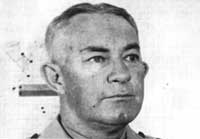| Marines in World War II Commemorative Series |
|
LIBERATION: Marines in the Recapture of Guam by Cyril J. O'Brien Coming Back to Guam Guam, along with the Philippines, became a territorial possession of the United States with the signing of the Treaty of Paris in 1899, ending the Spanish-American War. Earlier, on 21 June 1898, First Lieutenant John Twiggs "Handsome Jack" Myers had led a party of Marines ashore from the protected cruiser Charleston to accept the surrender of the Spanish authorities, who didn't know that a state of war then existed between Spain and the United States. Thus began a long Marine presence on Guam. The island, southernmost of the Marianas chain, was discovered by Ferdinand Magellan in 1521, but not occupied until 1688 when a small mission was established there by a Spanish priest and soldiers. When control of the rest of the Mariana Islands, including Saipan and Tinian, all once German possessions, was given to Japan as a mandate power in 1919, Guam became an isolated and highly vulnerable American outpost in a Japanese sea. This American territory, 35 miles long, nine miles at its widest and four at its narrowest, shaped like a peanut, with a year-long mean temperature of 79 degrees, fell quickly and easily in the early morning of 10 December 1941. Much of the Japanese attack on Guam came from her sister island of Saipan, 150 miles to the north.
The governor of Guam, Captain George J. McMillan (the island governor was always a U.S. Navy officer), aware that he could expect no reinforcement or relief, decided to surrender the territory to Japanese naval forces. Foremost in his mind was the fate of the 20,000 Guamanians, all American nationals, who would inevitably suffer if a strong defense was mounted. He felt "the situation was simply hopeless." He sent word to the 153 Marines of the barracks detachment at Sumay on Orote Peninsula and the 80-man Insular Guard to lay down their arms. Even so, in two days of bombing and fighting, the garrison lost 19 men killed and 42 wounded, including four Marines killed and 12 wounded. General Allan H. Turnage 
Allan R. Turnage was commissioned in 1913, and went to France as commanding officer of the 5th Machine Gun Battalion, 5th Brigade of Marines. In the interwar period, Turnage had an assortment of assignments to sea duty and to duty overseas, and in 1935 he reported as director of The Basic School, then at the Philadelphia Navy Yard. At the outset of World War II, he commanded Camp Lejeune and its training center, which was responsible for the organization and training of two regimental combat teams slated for duty with the 3d Marine Division. In October 1942 he became assistant division commander of the 3d Marine Division and its commander the next September. General Turnage led the division in the landing on Bougainville and the liberation of Guam. Following the end of the war, he became Assistant Commandant of the Marine Corps. Lieutenant General Turnage's final assignment was command of Fleet Marine Force, Pacific, at Pearl Harbor. Upon his retirement in 1948, because he was decorated in combat, he received a fourth star. He died in October 1971.
|



